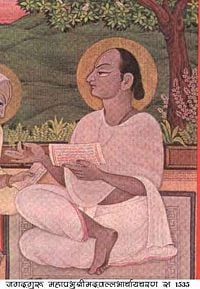Vallabha
| Indian philosophy Ancient philosophy | |
|---|---|
 | |
| Name: Akhand Bhoomandalacharya Jagadguru Mahaprabhu Shrimad Vallabhacharyachaji | |
| Birth: 1479 (Champaranya. Near Raipur, Chhattisgarh, India) | |
| Death: {{{death}}} | |
| School/tradition: Hindu_philosophy, Shuddhadvaita, Pushtimarg, Vedanta | |
| Main interests | |
| {{{main_interests}}} | |
| Notable ideas | |
| {{{notable_ideas}}} |
| Part of a series on Hindu philosophy | |

| |
| Schools | |
|---|---|
| Samkhya · Yoga | |
| Nyaya · Vaisheshika | |
| Purva Mimamsa · Vedanta | |
| Schools of Vedanta | |
| Advaita · Vishishtadvaita | |
| Dvaita · Shuddhadvaita | |
| Dvaitadvaita · Achintya Bheda Abheda | |
| Ancient figures | |
| Kapila · Patañjali | |
| Gotama · Kanada | |
| Jaimini · Vyasa | |
| Medieval figures | |
| Adi Shankara · Ramanuja | |
| Madhva · Madhusudana | |
| Tukaram · Namadeva | |
| Vedanta Desika · Jayatirtha | |
| Vallabha · Nimbarka | |
| Chaitanya | |
| Modern figures | |
| Ramakrishna · Ramana Maharshi | |
| Vivekananda · Narayana Guru | |
| A.C. Bhaktivedanta Swami Prabhupada | |
| N.C. Yati · Coomaraswamy | |
| Aurobindo ·Sivananda | |
| Satyananda · Chinmayananda | |
Vallabha or Sri Vallabhacharya (1479 - 1531) was a devotional philosopher, who founded the Pushti sect in India, and the philosophy of Shuddha advaita[1] [2] (Pure Non-dualism).
He is regarded as an acharya and guru within the Vaishnava traditions. Within Indian Philosophy he is known as the writer of sixteen 'stotras' (tracts) and produced several commentaries on the Bhagavata Purana, which describes the many lilas (pastimes) of the avatar, Krishna. Vallabha Acharya occupies a unique place in Indian culture as a scholar, a philosopher and devotional (bhakti) preacher. He is especially known as a lover and a propagator of Bhagavata Dharma. He was born in Champaran near Raipur in the Indian state of Chhattisgarh.
Childhood
The ancestors of Vallabha acharya lived in Andhra Pradesh. According to devotional accounts, 'Sri Thakorji' (Krishna) commanded Yagnanarayana that He would take birth in their family after completion of 100 Somayagnas (fire sacrifices). When Laxmana Bhatta, his descendant, completed 100 yagnas then Vallabhacharya was born in 1479 C.E. (V.S. 1535) on 11th day of the dark half of lunar month of chaitra at Champaranya. The name of his mother was Yallamma garu. Due to terror and physical strain of the flight suffered by the mother, there was a premature birth of child, two months in advance. As the child did not show signs of life, the parents placed it under a tree wrapped in a piece of cloth. It is believed that Krishna appeared in a dream before the parents of Vallabhacharya and signified that he had taken his birth as the child. The blessed mother extended her arms into the fire unscathed; she received from the fire the divine babe, gleefully to her bosom. The child was named as Vallabha since he was very dear to his parents.
Education
His education commenced at the age of seven with the study of four Vedas. He acquired mastery over the books expounding the six systems of Indian philosophy. He also learnt philosophical systems of Adi Sankara, Ramanuja, Madhva, Nimbarka along with the Buddhist and Jain schools. He was able to recite hundred mantras, not only from beginning to end but also in reverse order. At Vyankateshwar and Lakshmana Balaji, he made a strong impression on the public as an embodiment of knowledge. He was now applauded as Bala Saraswati.
Victory at Vijayanagara
A sensational debate was conducted at Vijayanagara between the Vaishnavaites of Madhva and Shankarites over the philosophical question whether God is Dualistic or non-dualistic - Vallabhacharyaji participated in the discussion considering it as a divine call. Vijayanagara was an empire in South India with its sovereignty over many states. The rulers of Vijaynagara were champions of Hinduism. Vallabhacharyaji who had earned an epithet of Bala Saraswati, was given the opportunity to discuss the question. The discussion continued for 27 days in the conference hall. The day of victory for Vaishnavas was celebrated with great pomp at Vijaynagara. He was honoured by the kanakabhisheka ceremony. The title of ‘Acharya’ and world preceptor was conferred on him. He was given vessels of gold weighing a hundred maunds. Vallabhacharya declined to accept them politely and distributed them among the poor brahmins and the learned only after keeping only seven gold mohurs. They were used for preparing the ornaments of their Lord Govardhananatha.
Piligrimage of India
Vallabhacharya performed three pilgrimages of India, barefooted. He wore a simple white dhoti and a white covering to cover the upper part of his body. (known as ‘Uparano’). He gave discourses on Bhagavata. He looked very bright, brilliant and his body depicted magnificent brilliance as a celibate. He gave discourses on Bhagavata at 84 places and explained the subtle meanings of the Puranic text. Even during present day these 84 places are visited by thousands of Hindu pilgrims and are referred to as "Chaurasi Bethak." He used to stay in Vraja for four months in each year.
Acharya
Acharya, the leader of spiritual preceptors, is one who has written his personal views and comments on the ‘Brahmasutra’, ‘Bhagavad Gita’ and ‘Upanishads’. Shankarcharya, Ramanujacharya and Madhvacharya had written their comments and obtained the designation of ‘Acharya’. Vallabhacharya was the fourth ‘Acharyaji’ of Indian culture. People then addressed him as Shri Vallabhacharya.
Establishment of Pushti Marg
It is believed that when Vallabhacharya entered Gokul, he thought about the important question of restoring people to the right path of devotion. He meditated on Krishna who appeared to him in a vision in the form of Shrinathji. He is said to have heard the BrahmaSambandha, mantra, a mantra of self dedication or consecration of self to Krishna. Vallabha Acharya related this experience to his worthiest and most beloved disciple, in the early morning,“Damala, did you hear any voice last night” ? Damodaradasa replied in negative. He became the first vaishnava. He wanted to preach his message of devotion to God and God’s grace called Pushti - Marga. He undertook three pilgrimages of India. He performed the initiation ceremony of religious rite by conferring on them ‘NamaNivedana’ mantra or ‘Brahma Sambandha’ mantra. Thousands of persons became his disciples but 84 devoted servants are famous and it is known as ‘Story of 84 Vaishnavas’.
Family
Vallabhacharyaji strictly adhered to three rules :
- He would not wear stiched clothes and hence always wore Dhoti and uparna (a cloth covering the torso)
- He always performed pilgrimages bare footed
- He always resided at the outskirts of the village. His sons and their descendants are known as "Goswami Maharajas".
He was to remain a life-long celibate but the guru Vitthalanatha of Pandharipur commanded him to marry and live the life of householder. He married a woman named ‘Mahakanya’ and had two sons: Gopinatha and Vitthalanatha (also known as Shri Gusainji).
Asura Vyamoha Lila
In 1530 C.E. Shrinathji commanded Vallabha acharya to leave the worldly life and to come near Him. Shrinathji had commanded previously to abandon worldly life at Madhuvamji and Gangasagarji. The third command was accepted by him as the last verdict. He reached Kasi and lived in a Parna Kutira (a cottage of leaves) on the Hanuman ghat for about a week. He spent his last days in contemplation of Vishnu and suffered agonies of separation from Him. The members of his family assembled near him for his last darshan. He wrote in the form of three verses and a half on sand by way of counsel. Krishna manifested visually on the spot and wrote in the form of a verse and a half. It is known as ‘ShikshaSloki’. He entered into the waters of the Ganges on the day of Rath Yatra (A festival that is celebrated on the second or third day of the bright side of the lunar month of Ashadha). A brilliant flame in the form of God arose from the water and it ascended to heaven and was lost in the firmament. This divine brilliant flame lived in the sky for three hours and it finally entered the cave of Giriraj mountain near Dandavati Shila. This episode is known as AsurVyamohLila. The forms of divine give up their lives at their sweet will and reach the region of permanent abode of the Divine. Goswami Maharajas and Vaishnava Society are indispensable part of Indian culture. Grace of God and love of God must go hand-in-hand. They make him as the be-all and end-all of all their desires, aspirations and efforts. They consider Krishna as the Supreme God, Supreme Transcendental Divine and Supreme Spirit.
See also
ReferencesISBN links support NWE through referral fees
- ↑ Shuddha-advaita Brahmvaad - Philosophy of Shree Vallabhacharyaji. Kankroli based Shri Vakpati Foundation. Retrieved 2007-06-06.
- ↑ [Govardhana] and Pravinacandra Cimanalala Parikha (1993-01). Vedanta Cintamanih of Bharatamartanda Pandita. Param Publications. ISBN 8186045007.
- Shri Vallabhacarya, His Philosophy and Religion - J.G.Shah, Nadiad Pushtimargiya Pustakalaya, 1969.
External links
- Vallabha Acharya (boloji.com)
- Acharya Vallabha and His Pushti Sampradaya (neovedanta)
- Jeevan Charitra Of Shri Mahaprabhuji in the form of a patrika
Credits
New World Encyclopedia writers and editors rewrote and completed the Wikipedia article in accordance with New World Encyclopedia standards. This article abides by terms of the Creative Commons CC-by-sa 3.0 License (CC-by-sa), which may be used and disseminated with proper attribution. Credit is due under the terms of this license that can reference both the New World Encyclopedia contributors and the selfless volunteer contributors of the Wikimedia Foundation. To cite this article click here for a list of acceptable citing formats.The history of earlier contributions by wikipedians is accessible to researchers here:
The history of this article since it was imported to New World Encyclopedia:
Note: Some restrictions may apply to use of individual images which are separately licensed.